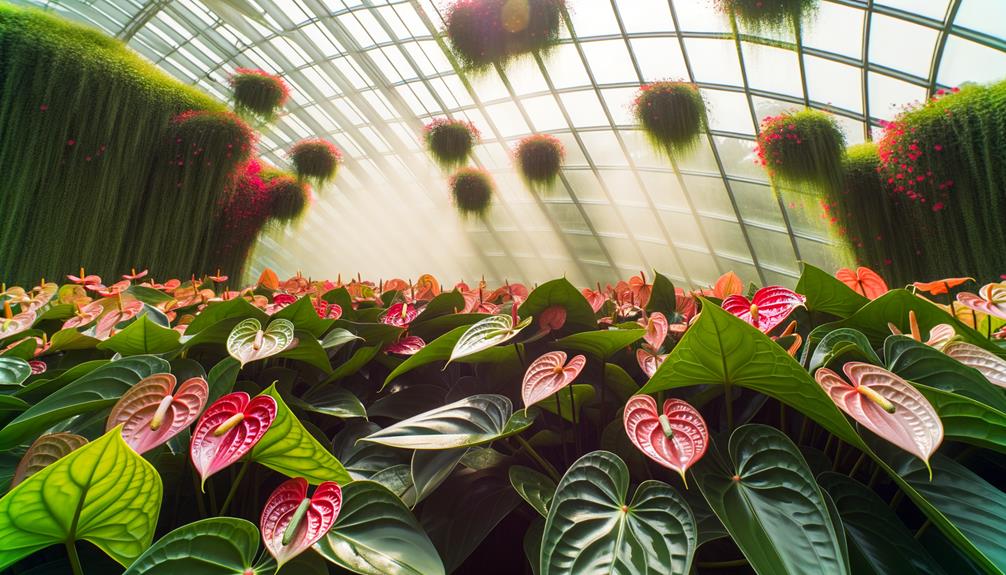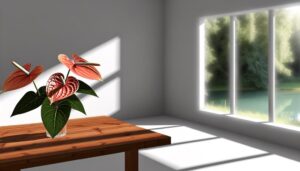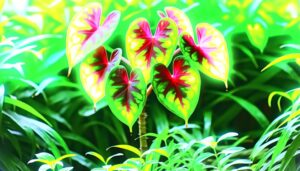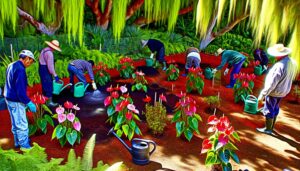Secrets to Enchanting Anthurium Flowers
Ensuring your Anthurium flowers are enchanting involves maintaining ideal growing conditions. Use well-ventilated soil with peat, pine bark, and perlite to facilitate root oxygenation and drainage, and keep pH levels between 5.5 and 6.5.
Provide bright, indirect sunlight and use filtered water when the top 1-2 inches of soil are dry. Maintain humidity at 60%-80% and temperatures between 65°F and 80°F.
Regularly deadhead spent blooms and inspect for pests. Consider seasonal adjustments, such as modifying watering frequency and using high-phosphorus fertilizers in the growing months.
Explore further to master the art of cultivating Anthurium flowers.

Key Takeaways
- Use a well-ventilated, nutrient-rich soil mix with peat, pine bark, and perlite for optimal drainage and root health.
- Provide bright, indirect sunlight to promote healthy growth and vibrant blooms.
- Maintain humidity levels between 60% and 80% and keep temperatures between 65°F and 80°F.
- Water with tepid, filtered water when the top 1-2 inches of soil are dry to avoid root rot.
- Regularly deadhead spent flowers to encourage new growth and prevent disease.
Choosing the Right Soil
Choosing the right soil for anthurium flowers is crucial, as these plants thrive in a well-ventilated, nutrient-rich mix that secures proper drainage and root oxygenation.
You'll want to create a substrate that combines peat, pine bark, and perlite. Peat offers organic richness and moisture retention, while pine bark provides a rough texture to improve aeration. Perlite ensures superb drainage, preventing waterlogging and root rot.
Aim for a pH level between 5.5 and 6.5 to maximize nutrient uptake. Incorporate slow-release fertilizers to provide essential nutrients gradually. Avoid compacted or excessively dense soils, which can stifle roots.
Regularly check for soil compaction and adjust as needed to maintain ideal conditions for your anthurium's health and growth.
Ideal Light Conditions
Promoting ideal growth for anthurium flowers also involves providing excellent light conditions, which demand bright, indirect sunlight to mirror their natural tropical habitat. You should place your anthurium in a location that receives filtered light to avoid direct sun exposure, which can scorch its leaves. Consider the following table for light intensity recommendations:
| Light Condition | Description |
|---|---|
| Bright, Indirect Light | Optimum; fosters healthy growth and flowering. |
| Low Light | Slows growth; fewer flowers; leggy appearance. |
| Direct Sunlight | Causes leaf burn; damages plant tissues. |
| Artificial Light | Use grow lights if natural light is insufficient. |
| Seasonal Adjustments | Rotate plant to balance light exposure year-round. |
Monitoring light conditions guarantees your anthurium thrives, preserving its vibrant colors and glossy foliage.
Proper Watering Techniques
To sustain your anthurium's health, it's crucial to implement a consistent watering schedule that aligns with its moisture needs and the surrounding environment. You should water when the top 1-2 inches of soil feel dry.
Use tepid, filtered water to avoid chlorine or fluoride damage. Ensure the pot has adequate drainage to prevent waterlogged roots, which can lead to root rot. Employ a moisture meter for precise measurement, aiming for a soil moisture level between 5 and 7 on the scale.
Avoid letting the soil completely dry out, as this stresses the plant. Monitor the frequency of watering based on seasonal changes, adjusting as necessary to maintain peak hydration levels.
Humidity Requirements
You must maintain humidity levels between 60% and 80% for prime Anthurium growth, simulating their native tropical environments.
Employ techniques such as misting, using a humidity tray, or positioning a humidifier nearby to guarantee moisture retention.
Monitoring and adjusting these factors will prevent desiccation and promote healthy, vibrant foliage.
Ideal Humidity Levels
Maintaining ideal humidity levels is necessary for the health and vibrancy of anthurium flowers. They thrive in environments with relative humidity between 70% and 80%. When humidity falls below this threshold, you'll notice physiological stress, indicated by browning leaf edges and reduced flower longevity.
High humidity facilitates best stomatal function, important for gas exchange and photosynthesis. This range also promotes efficient transpiration, preventing water stress and ensuring nutrient uptake.
Utilize a hygrometer to monitor ambient humidity precisely. If necessary, employ a humidifier or place the plant on a pebble tray with water to maintain consistent levels.
Moisture Retention Techniques
High relative moisture alone isn't enough; precise moisture retention techniques are essential to create the best growing conditions for anthurium flowers.
You should employ a well-draining potting mix incorporating components like peat moss, perlite, and pine bark to guarantee adequate aeration and water retention.
Regular misting helps maintain leaf turgor, but be careful not to overdo it, as excessive moisture can lead to fungal infections.
Utilize humidity trays or room humidifiers to sustain ambient moisture levels around 70-80%.
Monitoring soil moisture with a hygrometer allows you to adjust watering schedules accurately.
Temperature Preferences
Anthurium flowers thrive in a temperature range between 65°F and 80°F, ensuring ideal growth and vibrant blooms. Maintaining this thermal environment maximizes photosynthetic efficiency and metabolic processes.
To achieve this, consider these guidelines:
- Monitor Indoor Climate: Utilize a reliable thermometer to maintain consistent temperature control, avoiding fluctuations that could stress the plant.
- Avoid Drafts: Position your Anthurium away from windows and doors that may introduce cold drafts or sudden temperature changes.
- Use Humidity Trays: Elevated humidity levels complement the preferred temperature range, enhancing transpiration and nutrient uptake.
- Seasonal Adjustments: During colder months, employ heating pads or grow lights to sustain optimal warmth, preventing thermal dips that hinder growth.
Adhering to these recommendations will help your Anthurium flourish.
Fertilizing Tips
To complement the ideal temperature range, you'll need to apply a balanced fertilizer to guarantee robust growth and striking blooms in your Anthurium flowers. Opt for a 20-20-20 NPK (Nitrogen, Phosphorus, Potassium) formula, ensuring thorough nutrient availability.
Administer this solution bi-weekly during the growing season, diluting it to half strength to prevent nutrient toxicity. Nitrogen promotes foliage health, phosphorus supports root development and bloom production, while potassium enhances overall plant vigor.
Monitor for signs of nutrient imbalance such as chlorosis or stunted growth, adjusting the fertilization regimen accordingly. Additionally, incorporate micronutrients like magnesium and iron to address specific deficiencies, ensuring your Anthurium's metabolic functions remain at their best.
This methodical approach guarantees sustained energy and floral excellence.
Pruning and Deadheading
To maintain peak growth, you must employ precise pruning techniques, such as removing leggy or damaged stems using sterilized tools to prevent pathogen transmission.
Deadheading, or the removal of spent flowers, not only enhances the plant's aesthetic appeal but also directs energy towards new growth and flowering.
Regular pruning and deadheading are essential practices that promote robust health and vigorous blooming in Anthurium plants.
Proper Pruning Techniques
Effective pruning methods, including strategic deadheading, are crucial for maintaining the health and aesthetic appeal of your anthurium plants.
To achieve the best possible growth and flowering, follow these steps:
- Use Sterilized Tools: Always sterilize your pruning shears with rubbing alcohol to prevent pathogen transmission.
- Remove Yellowing Leaves: Cut off any discolored or wilted leaves at the base to redirect nutrients to healthy parts.
- Cut Above Nodes: When trimming, always cut just above a leaf node or bud to promote new growth and prevent dieback.
- Deadhead Spent Blooms: Remove faded flowers by cutting their stems close to the base; this reduces resource allocation to non-productive parts.
Benefits of Deadheading
By consistently removing faded anthurium flowers, you not only enhance their visual appeal but also promote vigorous new growth and improved blooming cycles. Eliminating spent blooms prevents the plant from expending energy on seed production, channeling resources towards healthy leaves and colorful flowers instead. This practice enhances the photosynthetic efficiency and overall strength of your anthurium.
Here's a breakdown of deadheading benefits:
| Benefit | Scientific Explanation |
|---|---|
| Enhanced Aesthetics | Eliminates unsightly spent blooms |
| Promoted New Growth | Diverts energy to vegetative tissues |
| Improved Blooming | Stimulates additional flower production |
| Disease Prevention | Reduces risk of fungal and bacterial infections |
Pest Control
When managing anthurium flowers, understanding and identifying common pests like aphids, spider mites, and mealybugs is essential for maintaining plant health. These pests can severely damage your anthuriums by feeding on sap, causing wilting, yellowing, and stunted growth. Implementing a precise approach guarantees effective pest control.
- Inspection: Regularly check the undersides of leaves for tiny insects or webbing.
- Isolation: Quarantine affected plants to prevent the spread to healthy ones.
- Mechanical Removal: Use a soft, damp cloth to wipe off visible pests manually.
- Biological Controls: Introduce natural predators like ladybugs or predatory mites to reduce pest populations.
Common Diseases
Although anthurium flowers are generally hardy, they're susceptible to common diseases like bacterial blight, root rot, and fungal leaf spots, which can compromise their health and robustness.
Bacterial blight, caused by Xanthomonas, manifests as water-soaked lesions on leaves, eventually leading to necrosis.
Root rot, often due to overwatering or poor drainage, results from fungal pathogens like Pythium and Phytophthora, causing root necrosis and plant wilting.
Fungal leaf spots, primarily caused by Colletotrichum and Alternaria, appear as circular, discolored lesions on leaves, reducing photosynthetic efficiency.
To mitigate these diseases, ensure proper sanitation, avoid excessive moisture, and apply fungicides or bactericides as necessary.
Monitoring and early intervention are essential for maintaining the vigor and enchanting beauty of your anthurium plants.
Repotting Guidelines
When repotting your Anthurium, choose a suitable soil mix rich in organic matter and well-draining components like perlite or orchid bark.
Select a pot size that allows for sufficient root expansion without causing waterlogging, usually one size larger than the current pot.
This promotes excellent root health and prevents common issues such as root rot.
Ideal Soil Mix
To achieve the finest growth and health of your Anthurium, use a well-draining soil mix comprising equal parts of orchid bark, perlite, and peat moss. This combination guarantees prime aeration, moisture retention, and root support.
Follow these steps to create the ideal soil mix:
- Orchid Bark: Provides structure and aeration, preventing root rot.
- Perlite: Enhances drainage and keeps the soil light, reducing compaction.
- Peat Moss: Retains moisture while maintaining a slightly acidic pH, ideal for Anthuriums.
- Mix Thoroughly: Guarantee even distribution to maximize the benefits of each component.
Pot Size Choice
Choosing the correct pot size is crucial for promoting optimal growth and preventing root-bound conditions in your Anthurium. When picking a pot, go for a diameter approximately 1-2 inches larger than the current one. This adjustment prevents excess soil moisture retention, which can result in root rot. Anthuriums prefer well-aerated roots, so make sure the pot has sufficient drainage holes.
Repotting should take place every 2-3 years, ideally in spring, to minimize transplant shock. Inspect the root system; if roots encircle the pot or extend from the drainage holes, it's time to repot. Use a sterile, sharp tool to trim any damaged roots. By following these recommendations, you'll encourage robust growth and sustain the well-being of your Anthurium.
Propagation Methods
Curious about multiplying your Anthurium collection? Propagation is a meticulous yet rewarding process. To maximize success, follow these scientifically-backed methods:
- Division: Gently separate mature plants with multiple stems. Ensure each division has a healthy root system to thrive independently.
- Stem Cuttings: Cut 6-inch segments with at least two nodes. Allow cut ends to callus before planting in a sterile medium.
- Seed Propagation: Although time-consuming, sow seeds in a well-draining mix, keeping them consistently moist and warm for best germination.
- Tissue Culture: Ideal for large-scale propagation, this involves cultivating cells in a controlled, sterile environment to produce genetically identical plants.
Seasonal Care Tips
Understanding the specific seasonal needs of Anthurium plants guarantees they flourish year-round, adapting their care to the changing conditions. During spring and summer, you'll need to increase watering frequency, making sure the soil remains moist but not waterlogged. Employ high-phosphorus fertilizers to support blooming.
In fall and winter, reduce watering to prevent root rot due to lower evaporation rates. Maintain a consistent temperature range of 60-85°F and humidity above 80%. Use a humidity tray or humidifier if necessary. Prune dead leaves to prevent fungal infections and promote new growth.
Guarantee adequate light by positioning Anthuriums in indirect sunlight, using grow lights if natural light wanes. This seasonal regimen optimizes Anthurium health and enhances their enchanting blooms.
Conclusion
Caring for anthurium flowers can be a delightful challenge, but with the right soil, light, and watering techniques, you'll master it.
Maintain ideal humidity and temperature to keep them thriving. Be vigilant against common ailments and repot when necessary.
Propagation can be your secret weapon for expanding your collection. By following these seasonal care tips, you'll cultivate an enchanting anthurium display, turning your space into a botanical haven.
Keep nurturing, and your efforts will be handsomely rewarded.






